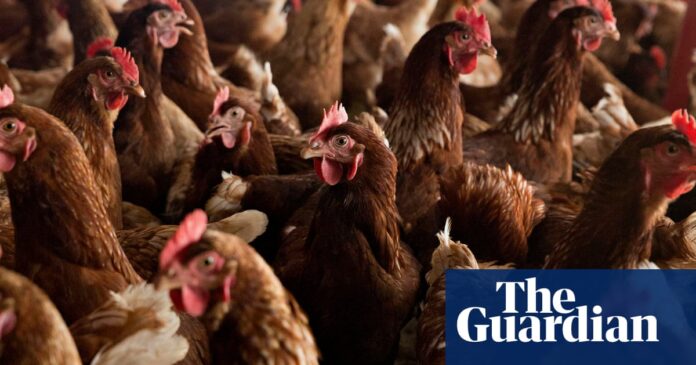Extreme heat could be a major factor behind the largest outbreak of bird flu among humans in the US, as authorities continue to monitor the spread of the virus.
A heat wave in Colorado likely caused personal protective equipment to fail for workers clearing poultry infected with H5N1, a highly pathogenic bird flu. Four people have tested positive for H5N1 and a fifth is also expected to be confirmed as having bird flu, officials said this week.
It is the first time a cluster of human cases of bird flu has been reported in the US.
Dairy farms are also finding it difficult for workers to wear PPE, in part because of the heat that’s spread across much of the U.S. Colorado confirmed a case of bird flu on a dairy farm earlier this month.
Climate change, which has been linked to intense heat across the country, could amplify outbreaks of deadly diseases like this, experts say. Climate change has also been linked to the emergence and wider spread of pathogens like this, including new migration patterns for H5N1-infected wild birds.
“When you change a global system like the climate so dramatically, small shifts can have big consequences, sometimes in unexpected ways,” said Alexandra Phelan, an associate professor at the Johns Hopkins Bloomberg School of Public Health.
In Colorado, workers cleared a flock of laying hens that tested positive for H5N1.
They worked bird by bird, catching them, putting them in a cart and killing a few dozen birds at a time with carbon dioxide gas.
“It’s a very, very manual, difficult, labor-intensive process,” Julie Gauthier of the U.S. Department of Agriculture’s (USDA) Animal and Plant Health Inspection Service said at a news conference Tuesday.
In addition, it can be dangerous to work in such a small space and for a long time with animals infected with bird flu. Among humans, the mortality rate from this disease is about 50%.
It was 40 degrees Celsius outside, but it was even warmer in the chicken coops.
Between the sweat and the huge industrial fans used to keep temperatures even higher, workers couldn’t keep their goggles and masks on their faces, Nirav Shah, deputy director of the U.S. Centers for Disease Control and Prevention (CDC), told reporters. The fans also spread feathers and debris, which could send the virus airborne, Shah said.
Of the 160 people who worked on the farm, 60 developed symptoms and five tested positive or are presumed positive. The remaining 55 workers tested negative for H5N1 at the Colorado state health lab, and some were diagnosed with other respiratory illnesses. Only symptomatic workers were tested.
“As the epidemiological investigation progresses, it is important to note that additional cases may be discovered,” Shah said.
Workers will continue to cull the chickens, which together make up a flock of 1.8 million birds, over the next 10 to 14 days, Eric Deeble, acting senior adviser for the H5N1 response at USDA, said during the briefing.
“USDA believes it is very important that depopulation continue to stop the replication and spread of viruses, prevent further spread, and reduce the viral load in the environment,” Deeble said. “If depopulation were to cease, workers would still have to care for and feed animals, which would prolong their exposure risk.”
Those involved in on-farm culling—including poultry producers, employees, contractors, and USDA workers—are required to wear Tyvek suits, N95 respirators, safety glasses, boots, and gloves when working with infected chickens.
When Colorado discovered possible human cases, it immediately alerted the CDC, which sent a team of 10 experts, including an occupational hygienist, to work on procedures to reduce exposure risks to workers as they continued to handle infected chickens, Shah said.
The CDC and the state of Colorado “are inseparable,” Shah said — unlike other farm outbreaks across the country, where the CDC typically has limited access to affected animals and people.
The poultry farm is located in the same region as the dairy herds that tested positive for bird flu.
Genomic sequencing shows these cases are closely related to the outbreak in dairy cows; it appears to have jumped from cows to chickens to people, though it’s not yet clear how. A USDA report from Michigan last month found that the virus can be carried between farms by people.
Climate change can negatively impact human health. It makes people more vulnerable to extreme weather events and spillovers like these. In addition, climate change changes animal interactions and migration patterns, which can lead to more spillovers.
It could even be responsible for the H5N1 outbreak in North and South America.
In late 2021, wild birds carrying the virus managed to fly from Northern Europe to Iceland and then to Newfoundland.
“One reason it happened is because of the unusually strong winds,” said Jean-Pierre Vaillancourt, a professor of veterinary medicine at the University of Montreal. It’s “very unusual” for the birds to travel that far, “but when this happened, we had really unusual climatic conditions,” he said.
“It’s not just the extreme heat. It’s the fact that you have unusual climate events,” Vaillancourt said. “It can disrupt the usual migration patterns” and other human and animal behavior, which poses new risks.
These are the first cases among U.S. poultry workers since 2022, when an inmate tested positive after culling infected chickens in Colorado.
The five workers in 2024 reported conjunctivitis (or “pink eye”) and watery eyes, as well as more typical flu symptoms, such as fever, chills, cough and sore throat, Shah said. None of them required hospitalization and all are recovering, he said.
The CDC has not changed its risk assessment for the general public or its policies for responding to outbreaks on farms, including recommendations on vaccines.
“The CDC does not recommend an H5-specific vaccine for livestock producers given the mild symptoms noted to date, in the absence of changes in the genetic makeup of the virus,” Shah said.
Research is also being done into vaccines for cows.
“We believe we can eliminate this problem in the dairy herd,” Deeble said.
“Improved biosecurity would get us to a point where we can stop the spread, and hopefully in the future we will have a vaccine that can further facilitate the elimination of this disease from national herds,” he said.
Officials must keep climate considerations high on the agenda as they respond to — and potentially eliminate — viruses like this, Phelan said. “Governments everywhere must actively and urgently integrate climate considerations into all health and safety measures, beyond surface-level considerations.”



